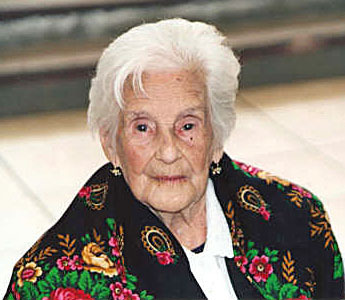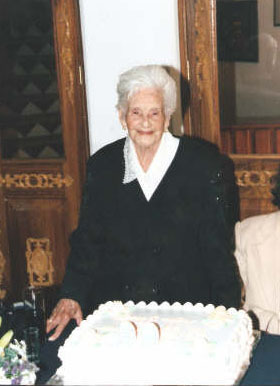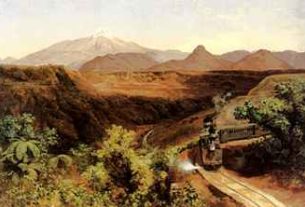At Home in Talpa de Allende, Jalisco

On January 10, 1906 María del Rosario Ramos Váldez was born in Talpa de Allende. Last year on her 102nd birthday, we celebrated with her at the nearby ranch of Lic. Ernesto Váldez, a long-time family friend.
Those of you who have read my contributions to Mexconnect may remember me introducing her to you in Secrets Hidden in the Sierras. She was one of my treasures. Doña Chayito was a fancy dresser back in her younger days. Talpa had cobblestone streets, as do many of our Mexican towns. High-heel shoes or boots are not cobblestone-friendly and, when maneuvered in long skirts, they are even less friendly.
My doll was prissing down the street one night more fifty years ago, kicked up her heels too high, fell against the curbstone and fracturing her femur. She spent three months in traction in a hospital after that fall. She suffered, at least, four more broken bones before the sixth and final one. She walked again, but with a special custom made built-up shoe and the help of a three-pronged walking stick.
Doña Chayito’s hospitality was renowned in Talpa. One of her daughters operates a restaurant in the big house where she lived. It was a special treat to be invited for lunch in La Hacienda’s private dining room where Doña Chayito held court. Only once in the fifteen years I knew her, she did not stand up to greet me when I came into her house or walk me to the door when I left.
Last July, my treasure dropped her napkin at the dining table. She bent over from her chair to pick it up, and the chair scooted from under her dumping her to the floor. Her hip was hurt, but local doctors missed the tiny crack in her femur.
She could still walk, but with great pain. She even attended our friend’s 90th birthday party in early August, but came in a borrowed wheelchair. Two other ladies rolled their wheelchairs up to her table. When I served her a piece of birthday cake, we joked about the “wheelchair table,” and she pointed out how many walking canes had come in the door that day.

Another doctor suggested she go to Guadalajara by ambulance for more X-rays. Her two daughters and their husbands went along with her, and her son flew in from Mexico City to be with her. She had surgery one afternoon at five o’clock. She came through surgery with flying colors and was to be released the following afternoon. And then, she faded and passed away.
I’ve lived my hours of regret that I didn’t ask her about things that only Doña Chayito could remember; many of them never written down as “history.” She talked about the Cristero War (1926-1929) as if it were yesterday. Plutarco Calles was president and he was an atheist in a country where Catholicism is the principal religion. In 1926, the federal government banned public worship and closed all schools operated by the church. The people rebelled, and the fight was bloody. Rebellion was heaviest in Jalisco, Guanajuato, Zacatecas and Aguascalientes. According to statistics, more than 90,000 people died, but not all of them died in battle, nor did the war between government and church actually end in 1929.
It seems that the two sides called a semi-truce, but many priests and laymen were butchered, shot or killed in some other tortuous manner on through the next decade.
There is a village called La Cumbre, more like a settlement, hidden in the mountains about an hour and a half drive over bad road from Talpa. There is a school and a church and every house has a dish antenna on its roof, but there are no stores. The roofs are wooden shingles. Supplies are brought in from Talpa or Seattle. We were told that most of the houses are owned by folks living in the United States. They come home at Christmastime, planting time and harvest time, and somebody must be in the shingle business.
When we asked for directions along the way, people would say, “Oh, you mean La Arrastra?” There are two or three versions of how La Cumbre got its nickname from the time of the Cristero War. One of the trails leading out of Talpa and down to the coast was over the highest mountain top, La Cumbre. Christian rebels lay in wait for the tired footsoldiers to come huffing and puffing up the mountain, took them by surprise and threw them into the valleys far below. Others claim hundreds of federal policemen were dragged to their death behind horses. (Dragged translates to arrastrado in Spanish.)
On May 21, 2000 twenty-seven martyrs from Jalisco were canonized. One of these men was Father José María Robles de Hurtado of Mascota, Jalisco. His life-size bronze statue stands in front of the church on the plaza in Mascota. The mold from his statue stands on the hilltop above my house. Saint José María was executed on June 26, 1927 along with twenty-six others in Quila, Jalisco.
Doña Chayito took great pride in telling me about a group of women who served during this war. They didn’t take up arms, but eleven women who lived in the Guadalajara area decided to help the Christian side by generating donations of money for food, clothing and ammunition for the Christian rebels. Most of them lived in Zapopan and they called themselves the Saints Joan of Arc. In less than six months, their number grew to about 10,000. By the time the war ceased, they numbered more than 25,000.
I’m not sure how long it takes to become a saint. I would have thought Pope John Paul II, Mother Theresa and Doña Chayito would have acquired sainthood the moment they breathed their last breath on this earth, but that is not, officially, the case. And since we’re being unofficial here, but reverent, consider them already saints. I know my beloved friend is one.

